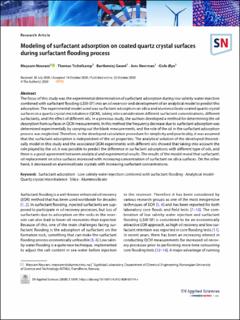| dc.contributor.author | Nourani, Meysam | |
| dc.contributor.author | Tichelkamp, Thomas | |
| dc.contributor.author | Gawel, Bartlomiej | |
| dc.contributor.author | Norrman, Jens | |
| dc.contributor.author | Øye, Gisle | |
| dc.date.accessioned | 2023-01-17T13:28:27Z | |
| dc.date.available | 2023-01-17T13:28:27Z | |
| dc.date.created | 2021-02-26T11:29:12Z | |
| dc.date.issued | 2020 | |
| dc.identifier.citation | SN Applied Sciences. 2020, 2 (11), . | en_US |
| dc.identifier.issn | 2523-3963 | |
| dc.identifier.uri | https://hdl.handle.net/11250/3044064 | |
| dc.description.abstract | The focus of this study was the experimental determination of surfactant adsorption during low salinity water injection combined with surfactant flooding (LSW-SF) into an oil reservoir and development of an analytical model to predict this adsorption. The experimental model used was surfactant adsorption on silica and aluminosilicate coated quartz crystal surfaces in a quartz crystal microbalance (QCM), taking into consideration different surfactant concentrations, different surfactants, and the effect of different oils. In a previous study, the authors developed a method for determining the oil desorption from surfaces in QCM measurements. In this method the frequency decrease due to surfactant adsorption was determined experimentally by carrying out the blank measurements, and the role of the oil in the surfactant adsorption process was neglected. Therefore, in the developed calculation procedure for simplicity and practicality, it was assumed that the surfactant adsorption is independent of the oil properties. The analytical solution of the developed theoretically model in this study and the associated QCM experiments with different oils showed that taking into account the role played by the oil, it was possible to predict the difference in surfactant adsorptions with different type of oils, and there is a good agreement between analytical and experimental results. The results of the model reveal that surfactant\oil replacement on silica surfaces increased with increasing concentration of surfactant on silica surfaces. On the other hand, it decreased on aluminosilicate crystals with increasing surfactant concentrations. | en_US |
| dc.language.iso | eng | en_US |
| dc.publisher | Springer | en_US |
| dc.rights | Navngivelse 4.0 Internasjonal | * |
| dc.rights.uri | http://creativecommons.org/licenses/by/4.0/deed.no | * |
| dc.title | Modeling of surfactant adsorption on coated quartz crystal surfaces during surfactant flooding process | en_US |
| dc.title.alternative | Modeling of surfactant adsorption on coated quartz crystal surfaces during surfactant flooding process | en_US |
| dc.type | Peer reviewed | en_US |
| dc.type | Journal article | en_US |
| dc.description.version | publishedVersion | en_US |
| dc.source.pagenumber | 13 | en_US |
| dc.source.volume | 2 | en_US |
| dc.source.journal | SN Applied Sciences | en_US |
| dc.source.issue | 11 | en_US |
| dc.identifier.doi | 10.1007/s42452-020-03714-x | |
| dc.identifier.cristin | 1894003 | |
| cristin.ispublished | true | |
| cristin.fulltext | original | |
| cristin.qualitycode | 1 | |

